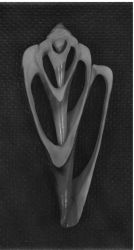Gastropoda
The largest and most varied class in the phylum Mollusca, possibly numbering over 74,000 species and commonly known as snails.
General characteristics
The shell is in one piece which, in the majority of forms, grows along a turbinate (equiangular) spiral (see illustration), but which is modified into an open cone in various limpets or is secondarily lost in various slugs.
All gastropods, at some time in their phylogeny and at some stage in their development, have undergone torsion. The process does not occur in any other mollusks. It implies that the visceral mass and the mantle shell covering it have become twisted through 180° in relation to the head and foot. As a result of torsion, all internal organs are twisted into a loop. Similarly in gastropods, the mantle cavity (the semi-internal space enclosed by the pallium or mantle) containing the characteristic molluscan gills (ctenidia) has become anterior and placed immediately above and behind the head. The most primitive gastropods retain a pair of aspidobranch (bipectinate or featherlike) gills, each with alternating ctenidial leaflets on either side of a ctenidial axis in which run afferent and efferent blood vessels. Lateral cilia on the faces of the leaflets create a respiratory water current (toward the midline and anteriorly) in the direction opposite to the flow of blood through the gills, to create the physiological efficiency of a countercurrent exchange system.
Classification and diversity
The usual systematic arrangement of the class Gastropoda involves three somewhat unequal subclasses. The first, the largest and most diverse, is the subclass Prosobranchia, which is made up largely of marine snails all retaining internal evidence of torsion. Prosobranchs are divided into at least four orders: Archaegastropoda, Caenogastropoda, Neritida, and Patellogastropoda; three superfamilies remain to be assigned to one of the four orders, and may each comprise a distinct order. The other two subclasses (Opisthobranchia and Pulmonata) are each considerably more uniform than the subclass Prosobranchia and, in both, the effects of torsion are reduced or obscured by secondary processes of development and growth.
More than half of all molluscan species are gastropods, and they encompass a range from marine zygobranchs, which can be numbered among the most primitive of all living mollusks, to the highly evolved terrestrial air-breathing slugs and snails. Pulmonates and certain mesogastropod families are the only successful molluscan colonizers of land and fresh waters.
Fossils
Fossil gastropods have a long geologic history, being common throughout the Paleozoic and increasingly abundant in the Mesozoic and Cenozoic. All three subclasses are known in the fossil record; many superfamilies, particularly prosobranchs, are extinct. Average duration of a genus has been estimated to range from 30,000,000 to 90,000,000 years.
Marine gastropods are important stratigraphic indicators in Cenozoic strata and locally are abundant in Cretaceous rocks. They are less common and less useful in the Jurassic and Triassic. Although individual genera have stratigraphic utility within the Paleozoic, it is only in the Ordovician that they are significant for correlation. See Mollusca
